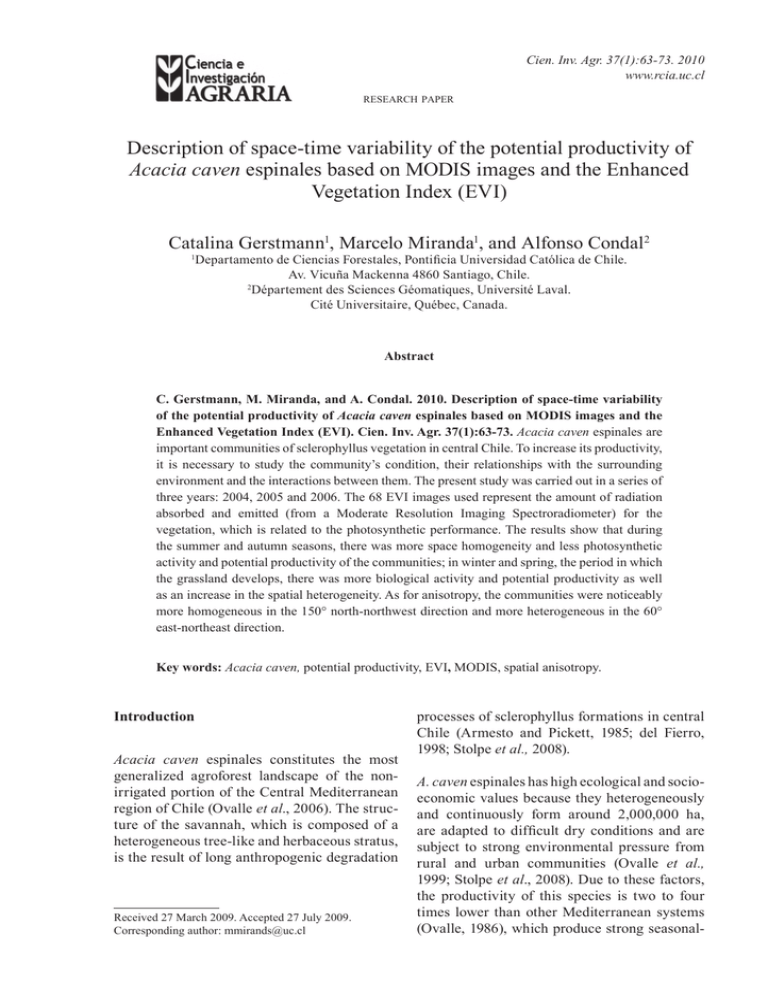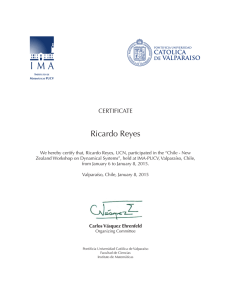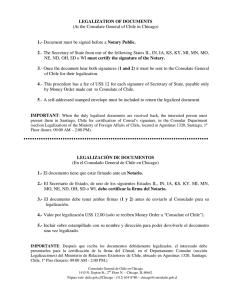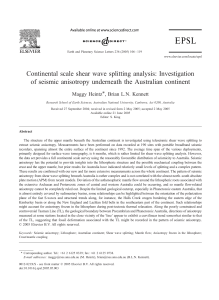Description of space-time variability of the potential
Anuncio

Cien. Inv. Agr. 37(1):63-73. 2010 www.rcia.uc.cl research paper Description of space-time variability of the potential productivity of Acacia caven espinales based on MODIS images and the Enhanced Vegetation Index (EVI) Catalina Gerstmann1, Marcelo Miranda1, and Alfonso Condal2 Departamento de Ciencias Forestales, Pontificia Universidad Católica de Chile. Av. Vicuña Mackenna 4860 Santiago, Chile. 2 Département des Sciences Géomatiques, Université Laval. Cité Universitaire, Québec, Canada. 1 Abstract C. Gerstmann, M. Miranda, and A. Condal. 2010. Description of space-time variability of the potential productivity of Acacia caven espinales based on MODIS images and the Enhanced Vegetation Index (EVI). Cien. Inv. Agr. 37(1):63-73. Acacia caven espinales are important communities of sclerophyllus vegetation in central Chile. To increase its productivity, it is necessary to study the community’s condition, their relationships with the surrounding environment and the interactions between them. The present study was carried out in a series of three years: 2004, 2005 and 2006. The 68 EVI images used represent the amount of radiation absorbed and emitted (from a Moderate Resolution Imaging Spectroradiometer) for the vegetation, which is related to the photosynthetic performance. The results show that during the summer and autumn seasons, there was more space homogeneity and less photosynthetic activity and potential productivity of the communities; in winter and spring, the period in which the grassland develops, there was more biological activity and potential productivity as well as an increase in the spatial heterogeneity. As for anisotropy, the communities were noticeably more homogeneous in the 150° north-northwest direction and more heterogeneous in the 60° east-northeast direction. Key words: Acacia caven, potential productivity, EVI, MODIS, spatial anisotropy. Introduction Acacia caven espinales constitutes the most generalized agroforest landscape of the nonirrigated portion of the Central Mediterranean region of Chile (Ovalle et al., 2006). The structure of the savannah, which is composed of a heterogeneous tree-like and herbaceous stratus, is the result of long anthropogenic degradation Received 27 March 2009. Accepted 27 July 2009. Corresponding author: mmirands@uc.cl processes of sclerophyllus formations in central Chile (Armesto and Pickett, 1985; del Fierro, 1998; Stolpe et al., 2008). A. caven espinales has high ecological and socioeconomic values because they heterogeneously and continuously form around 2,000,000 ha, are adapted to difficult dry conditions and are subject to strong environmental pressure from rural and urban communities (Ovalle et al., 1999; Stolpe et al., 2008). Due to these factors, the productivity of this species is two to four times lower than other Mediterranean systems (Ovalle, 1986), which produce strong seasonal- 64 ciencia e investigación agraria ity and space variability (Aurtenechea, 2007; Gerstmann, 2008). Different methods have been developed to determine the productivity of espinales and alternatives for silvicultural management and restoration (Ovalle, 1986; Vita, 1993; Ovalle et al., 1999; Ovalle et al., 2006). However, few studies have focused on the determination of the spacetime variability of productivity using techniques associated with remote rensing and space statistics (Ovalle et al., 1996; Aurtenechea, 2007; Gerstmann, 2008). The space-time study of espinales is feasible because satellite images along with information provided by the vegetation indices are available (NASA, 2007). The vegetation indices, which were created to monitor the fluctuations in potential vegetal productivity, are relationships that quantify the concentration of green leaves present in the plants that is indicative of the amount of energy absorbed and emitted by those organisms for a certain period (Earth Observatory, 2007). The Enhanced Vegetation Index (EVI) corresponds to the amount of photosynthetically active tissue, while the leaf area index (LAI) measures the foliage density (NASA, 2007; TBRS, 2007). These indices both are directly related to the photosynthetic primary production of the vegetation (Fensholt et al., 2004; Glenn et al., 2008). In nature, organisms live in habitats that are highly heterogeneous with respect to space and time (Maestre, 2002), and this heterogeneity promotes distributions in the aggregate or gradient arrangements (Maestre, 2002; Legendre and Legendre, 2003; Miranda, 2007). Thus, the attributes of the individual are linked to the features of their neighbors due to the existence of space dependence (Miranda-Salas and Condal, 2003; Miranda, 2007). To describe the space dependence of a variable, structural functions from the space statistics are used, where the semivariance, the Moran Index and the Cartogram are the most common functions (Isaaks and Srivastava, 1989; Govaerts, 1997). The spatial statistic include the spatial heterogeneity as the object of study and allow the characteriza- tion of the spatial patterns of different attributes of vegetation (Aurtenechea, 2007; Miranda, 2007). This information can be used for the development of management activities that better exploit the vegetal resources available at a given time. For a continuous space phenomenon, the space dependence may vary according to the direction (anisotropy) or may be homogeneous in every direction (isotropy) (Emery, 2000; Legendre and Legendre, 2003; Fortin and Dale, 2005). This measure is the result of self-organization processes of the vegetal communities in their medium, which occur in multiple space and time scales. The objective of this study was to determine the space-time behavior of the potential productivity of Acacia caven espinales as a result of variations in the EVI values, the degree of space dependence, the formation of spatial structures (patches or gradients) and the presence of directions of dominant variability (anisotropy). The study was performed in the Rapel River basin, which is located in the Mediterranean region of Central Chile. Materials and methods Area of study The area of study was located in the Rapel Lake basin on the eastern side of the Coastal Mountain Chain that extends between 33°40’ and 34°20’ south latitude and between 71°20’ and 72°20’ west longitude. The area was a regular rectangular surface of 4.197 km 2, where the hawthorn communities cover a total of 1.200 km2. The Mediterranean temperate climate type is characterized by a long dry season but with mild temperatures in the summer (Santibañez and Uribe, 1993). The annual and daily temperatures were low, with an annual average of 14-15ºC. On the other hand, the annual precipitation varies between 470 and 530 mm (Dirección Meteorológica de Chile 2004, 2005, 2006; Government of Chile, 2007). VOLUME 37 Nº1 JANUARY - APRIL 2010 Satellite Images The present study was performed using 68 images that contained the EVI products and were already processed from satellite images from the MODIS MOD13Q1. Each of the 68 images, which corresponded to a series of three years (2004, 2005 and 2006), has a space resolution of 250 m and a time resolution of 16 days. The images were obtained from the NASA EROS Data Center website (http://edc.usgs.gov/), where each pixel contained the maximum EVI value and an estimation of the Nadir value within a range of 16 days. This procedure is known as the Maximum Value Composition (MVC) (NASA, 2007). 65 fulfill the basic conditions for application to a specific population model. In the first stage, the analysis focused on the description of the frequency distribution types and their degree of likelihood in relation to a normal distribution of the EVI values. Therefore, graphical analyses and amplitude, central tendency, variability and structure measurements were used (MirandaSalas and Condal, 2003). Space analysis. Experimental variogram and cartogram functions were used to study the space variability and anisotropy (Equation 1), which both measures the dissimilarity or variability between two values separated by a certain distance and expressed as the semivariance (Issaks and Srivastava, 1989; Emery, 2000; 2007). Hawthorn communities The A. caven communities studied were located inside the vegetal formation called the “Mediterranean Coastal Hawthorn Forest of Acacia caven and Maytenus boaria” according to the ecological classification of Luebert and Pliscoff (2006). They were selected based on the information available in the Register of Native Forests (CONAF-CONAMA-BIRF, Santiago, Chile, 1999), where the selection criterion used was vegetation polygons containing hawthorn as the dominant species (more details about the polygons used as selection criteria can be found in Aurtenechea, 2007). Then, the EVI values were extracted for each corresponding polygon in the 68 selected images. Finally, a sample of 4.430 polygons (20% of the population) was selected at random and used in this study. Methods Statistical exploratory analysis. In the analysis of a series of data, one of the first stages is the description of the distribution and specific estimation of the basic statistics to verify that they (1) where, γ(h) is the EVI semivariance to the distance h, z(xi) and z(xi + h) are the values of the attribute Z, which in this case is the EVI value, in the locations xi and xi+h and N is the number of pairs. When the pair of data points is separated by a short distance, the value of the semivariance also decreases, indicating a strong spatial structure. As the distance increases, the semivariance value increases and reaches a maximum point called the sill (Fortin and Dale, 2005), which is when the maximum variability occurs. The distance between the sampled pairs of data is known as the range and indicates the maximum distance at which the variable of interest is spatially self-correlated (Fortin and Dale, 2005; Miranda, 2007). For the interpretation of the results, four seasons were defined. Summer was considered to be the period between December 18 and March 20; autumn was between March 21 and June 24; winter was between June 25 and September 28; and spring was between September 29 and December 17. ciencia e investigación agraria 66 In addition, high and low EVI values were related to high and low levels of potential productivity of the espinales for the interpretation of the satellite data, according to Fensholt et al. (2004) and Glenn et al. (2008). All analyses were performed with the ENVI 4.2 image processing system (Research Systems, Inc., Colorado, USA, 2005), the ArcView GIS 3.2 geographical information system (Environmental Systems Research Institute Inc., California, USA, 1991) and the S-Plus 6.0 (Insightful Corp., Washington, USA, 1990) and GS+ 7.0 (Gamma Design Software, Michigan, USA, 1996) statistical analysis programs. (Figure 1). The values were low in the summer and fall, with the minimum observed in MarchApril-May (0,23 ± 0,06), whereas in winter and spring, the index of vegetation was high, with the maximum values observed in SeptemberOctober (0,36 ± 0,08). In addition, an increase in the time tendency of EVI was observed, which was evident in the trendline in the graphic. This line exhibited average EVI values that were close to 0,25 for the beginning of 2004 and over 0,30 at the end of 2006, which is an increase of 0,17 EVI units per year (Figure 1). With regard to the EVI space distribution, there was higher potential productivity (high Results EVI values) in the western sector of the area of study. This situation was observed mainly in the �������� summer and was reversed in the winter months EVI average �������������������������������������������������������������������������������������������� (Figure 2a). The lowest values for potential productivity were found in the south and showed &����������������� The average EVI value in the area of study the opposite behavior in the winter (Figures 2a showed a����������!�����������"�#�������������������������$������������������%���������������������� periodic behavior over 12 months and b). ����� � Figure 1. Average EVI behavior in summer, autumn, winter and spring of years 2004, 2005 'and 2006. � VOLUME 37 Nº1 JANUARY - APRIL 2010 67 a) Summer: 25 February, 2004. b) Winter: 04 August, 2004. Figure 2. A. caven communities distribution in the study area by EVI’s standard deviation. Spatial statistics Similarly to the average EVI values, the sill also showed a periodic behavior over 12 months, with the maximum values associated with July, August and September (0.005±0.001) and the minimum values with March, April and May (0.003±0.001). As observed in Figure 3, there was a positive relationship between the EVI values and the maximum space variability represented by the sill (r = 0,77; P < 0,05), where the summer and fall seasons were more spatially homogeneous compared with the winter and spring, which showed the highest space heterogeneity. Unlike the sill, the range did not maintain a clear pattern of behavior. The hawthorn communities presented a spatial pattern of patches that varied between 2,000 and 6,000 m. On average, the summer and fall seasons showed a larger outreach (4,277 m), while the range tended to be smaller in winter and spring (3,702 m) (Figure 4). ciencia e investigación agraria 68 ���������������������������������� ���������������������������������������������������������� ������������ ��������&��������������������������������������������������������������������������� &���������3�����"�#�������������������������$������������������%�������������������������� ��������&�����"�#�������������������������������������$���������������� & � Figure 3. EVI behavior versus sill in summer, autumn, winter and spring. � Figure 4. Range behavior in summer, autumn, winter and spring of years 2004, 2005 and 2006. � Anisotropy From the 68 images of EVI products analyzed using the cartogram, 60 presented evident � anisotropy and 8 showed isotropy. The anisotropy angles varied between 123° and 167° in the north-northwest (N-NW), with the most frequent angles in the range of 145° and 155° (58.82%). The remaining percentages were divided into the other four classes in a relatively proportional manner (Figure 5). The anisotropy tended to remain stable from 140° to 155°. The angles were stable for each season; the angles were on average 148° for the summer-fall and 146° for the winter and spring. The anisotropy angles were more erratic in the � winter, when the greatest isotropic behavior was � observed (Figures 5 and 6). & In Figure 7, a selection of the most representative images from each season is shown. The anisotropy angles for images a), b), c) and d) were 142°, 156°, 128° and 150°, respectively. The anisotropy direction behaved rather uniformly among the different seasons, as well as between years, except for Figure 7c, which had a lower angle. In addition, variations in the outreach, where the communities began to be independent, were evident. This range varied and was higher in the summer and lower in the winter. ����������4���������������)����5���������+�������������������6��������)�������������������*��)� ����������!�����������������#����������������)�������������������)�"�#����� & Figure 5. Anisotropy angles histogram and percentage and isotropic behavior. ����������7�����������+%�)��������8�������������� VOLUME 37 Nº1 JANUARY - APRIL 2010 69 �������������������������%��#������������ & a) 08 November, 2004. � b) 08 November, 2005. c) 08 November, 2006. �������'�7�����������+%�)��������8����������������������������������������������������� � ���.��1����������"���������� Figure 6. Variogram map of the study area. �������'����������������%��#��������������������������������$���������������� ��".��1����������"���������� ').��1����������"���������� 1 2�.��1�9����"�������� ��".��1�9����"�������� ��).��1�9����"�������� �� & � a) 25 February, 2006. �c) 04 August, 2004. b) 16 May, 2004. d) 08 November, 2005. 7. Variogram map of the study area in summer, autumn, winter and spring. �.�������%�"������������ � ".������������������� �Figure �).��������������������� � �.��1����������"���������� ' 1�.������"����������� ".����7�������� � 70 ciencia e investigación agraria Discussion The EVI is strongly associated with the leaf area index, which relates directly to the instantaneous photosynthetic activity of the plants and their potential productivity (Fensholt et al., 2004; Glenn et al., 2008). This demonstrates that the hawthorn communities had higher potential productivity in the winter and spring, while their potentials decreased in the summer and fall (Figure 1). When compared with the observations by Ovalle et al. (1990), it is reasonable to say that the net potential hawthorn productivity increases in the summer, when the herbaceous stratus, which corresponds to the Mediterranean grassland, is dry. In contrast, the activity of several different life forms (trees, bushes and herbaceous plants) is observed in the winter because the grassland is active. The response to this increase in the potential productivity in the winter may be associated with the increase in the photosynthetic activity of trees and bushes as well as with the growth of the herbaceous stratus, mainly in areas close to Rapel Lake (Figure 2). Regarding the spatial structure of the potential espinales productivity, there was a strong relationship between the vegetation activity and the space heterogeneity. An increase in the biotic activity of the hawthorn communities, which is expressed as an increase in the EVI index, coincided with a rise in the space heterogeneity, i.e., an increase in the disorder of the communities, which is related to the values reached by the sill in these months. The maximum EVI occurred in winter and coincided with the development of the herbaceous stratus. In the summer and fall seasons, the communities presented lower space variability (more homogeneous, due to the low values of the sill). This status was associated with the space homogeneity presented by the hawthorns in the summer months, when the seasonal herbaceous cover is absent (Figure 3). Similar results have been observed in temporal studies of the space variability of attributes of Pinus radiata plantations on an annual scale (Miranda, 2007) and diseases in cotton plantations (Stein et al., 1998). Due to the spatial structure, a smaller outreach (range) in the homogeneity within the communities was observed in the winter, i.e., when the espinales began to be independent (Figure 7c). However, the range could not be exactly defined in the spring and in the two other months (Figure 4). The potential productivity of the espinales had a strong dominant north-northwest (N-NW) direction, which is known as anisotropy (Figure 5). This shows that the greatest spatial similitude among the hawthorn communities was located in that direction, in relation to its potential productivity that was expressed as EVI values. In contrast, the east-northeast direction (E-NE) showed greater space heterogeneity for the area of study. The anisotropy angles remained stable with time and the seasons, except for winter, when they were more erratic and showed higher heterogeneity in the spatial structure of the communities (Figures 5, 6 and 7). It is noteworthy that it was possible to observe the presence of isotropy on a local scale that resulted from the comparison of pixels of images located a few meters away (Figures 6 and 7). To explain the presence of the anisotropy, two hypotheses are possible. The first proposes that it might result from self-organization processes among the vegetal communities with environmental factors, such as topography and climate (Perry et al., 2002; Miranda, 2007; Wang et al., 2007). The second proposes that the anisotropy arises from the polarization generated in the digital images due to the capture angle of the sensors compared to the sun and the terrain surface (Camacho de Coca et al., 2002; PrietoBlanco et al., 2009). Finally, from a practical point of view, the results obtained in this work may improve the VOLUME 37 Nº1 JANUARY - APRIL 2010 vegetal resource management strategies associated with hawthorn communities. Farmers and cattle farmers could use this information to determine when and where the highest potential productive activity, expressed as EVI values, will occur, determine the variability degree in space and time and observe the sill as well as range values that it represents. In conclusion, the potential productivity of the hawthorn community, expressed as EVI values, may be grouped according to the seasons; one group was formed in the winter and spring and the other group in the fall and summer. The combined effect of several vegetal forms (hawthorn along the annual herbaceous stratus) was observed in the winter and spring. The photosynthetic activity and the EVI values of the hawthorn communities increased in this period. In addition, it was observed that the communities had high spatial heterogeneity and the distance, where the maximum variability occurs (range), tended to be shorter. An effect essentially associated with hawthorns was observed in the summer and fall, when the grassland is 71 dry. The photosynthetic activity and growth decreased in this period. It was also observed that the communities were spatially more homogeneous, and the distance at which the maximum variability occurs (range) tended to be higher. In terms of distribution, highest productive activity was observed at the coastal border of the Rapel River basin. Finally, the anisotropy angle was maintained throughout the years, as well as the seasons, except in winter, when the directions were more varied and the presence of isotropy was observed. Acknowledgements The authors thank CONAF-CONAMA-BIRF for providing the “Catastro y evaluación de recursos vegetacionales nativos de Chile” database and the National Aeronautics and Space Administration (NASA) for making the MODIS images available; without them, this study would not have been possible. They also thank the valuable comments provided by the two reviewers of this work. Resumen C. Gerstmann, M. Miranda y A. Condal. 2010. Descripción de la variabilidad espaciotemporal de la productividad potencial de espinales de Acacia caven basada en imágenes MODIS e Índice de Vegetación Mejorado, EVI. Cien. Inv. Agr. 37(1):63-73. Los espinales de Acacia caven son importantes comunidades de la vegetación esclerófila de Chile central. Para aumentar el valor de su productividad potencial, es necesario estudiar las condiciones de las comunidades, su relación con el medioambiente que les rodea y las interacciones entre ellas. El presente estudio fue llevado a cabo usando 68 imágenes con EVI (provenientes del sensor Moderate Resolution Imaging Spectroradiometer) para una serie de tiempo de tres años: 2004, 2005 y 2006. Estas imágenes representan la cantidad de radiación absorbida y emitida por la vegetación, la cual está relacionada con el estado de la productividad potencial y la actividad fotosintética instantánea. Los resultados muestran que durante las estaciones de verano y otoño existe una mayor homogeneidad espacial y una menor productividad potencial de las comunidades; mientras que en invierno y primavera, período en el cual se desarrolla la pradera, ocurre una mayor actividad biológica e incrementa la heterogeneidad espacial. En cuanto a la anisotropía, las comunidades son notablemente más homogéneas en la dirección 150° NorNoroeste, y más heterogéneas en la dirección 60° Este-Noreste. Palabras clave: Acacia caven, productividad potencial, EVI, MODIS, anisotropía espacial. 72 ciencia e investigación agraria References Armesto, J., and S. Pickett. 1985. Removal experiments to test mechanisms of plant succession in oldfields. Plant Ecology 66:85-93. Aurtenechea, A. 2007. Análisis de patrones espaciales en espinales de Acacia caven vía estadística espacial y Sistemas de Información Geográfica. Proyecto de Título. Facultad de Agronomía e Ingeniería Forestal. Pontificia Universidad Católica de Chile. Santiago. Chile. 55 pp. Camacho de Coca, F., F. Garcia-Haro, M. Gilabert, and J. Meliá. 2002. La anisotropía de la BRDF: Una nueva signatura de las cubiertas vegetales. Revista de Teledetección 18:29-46. Del Fierro, P. 1998. Experiencia silvicultural el boque nativo de Chile. Corporación Nacional Forestal (CONAF). Santiago. Chile. 420 pp. Dirección Meteorológica de Chile, Meteorología agrícola. 2004. Boletín Agrometeorológico N° 159. Enero-Diciembre. Santiago. Chile. Dirección Meteorológica de Chile, Meteorología agrícola. 2005. Boletín Agrometeorológico. N° 160. Enero-Diciembre. Santiago. Chile. Dirección Meteorológica de Chile, Meteorología agrícola. 2006. Boletín Agrometeorológico N° 161. Enero-Diciembre. Santiago. Chile. Earth Observatory. 2007. Available online at: http:// earthobservatory.nasa.gov/Library/MeasuringVegetation/ (Accessed: December 2007. Emery, X. 2000. Geoestadística lineal. Cátedra CODELCO de evaluación de yacimientos. Departamento de Ingeniería de Minas. Facultad de Ciencias Físicas y Matemáticas. Universidad de Chile. Santiago. Chile. 411 pp. Emery, X. 2007. Curso Geoestadística. Diplomado en Geomática Aplicada. Universidad de Chile. Santiago. Chile. 144 pp. Fensholt, R., I. Sandholt, and M. Rasmussen. 2004. Evaluation of MODIS LAI, fAPAR and the relation between fAPAR and NDVI in a semi-arid environment using in situ measurements. Remote Sensing of Environment 91:490-507. Fortin, M., and M. Dale. 2005. Spatial analysis. Cambridge University Press. Cambridge. UK. 365 pp. Gerstmann, C. 2008. Estudio de la variabilidad espacio-temporal de la productividad de Acacia caven en base a imágenes MODIS e Índice de Vegetación Mejorado, EVI. Cuenca del río Rapel, Chile. Informe de residencia Departamento de Ciencias Forestales, Pontificia Universidad Católica de Chile. Santiago. Chile. Glenn, E., A. Huete, P. Nagler, and S. Nelson. 2008. Relationship between remotely-sensed vegetation indices, canopy attributes and plant physiological processes: What vegetation indices can and cannot tell us about the landscape. Sensor 8: 2136-2160. Gobierno de Chile. 2007. Available online at: www. gobiernodechile.cl. (Accessed: December 2007. Goovaerts, P. 1997. Geostatistics for Natural Resources Evaluation. Oxford Univ. Press, NY, USA. 483 pp. Isaaks, E., and R. Srivastava. 1989. An Introduction to Applied Geostatistics. Oxford University Press, NY, USA. 561 pp. Legendre, P., and L. Legendre. 2003. Numerical Ecology. Elsevier Science B.V. Amsterdam. The Nettherlands. 853 pp. Luebert, F., and P. Pliscoff. 2006. Sinopsis Bioclimática y Vegetacional de Chile. Editorial Universitaria. Santiago. Chile. 316 pp. Maestre, F. 2002. La restauración de la Cubierta Vegetal en Zonas Semiáridas en Función del Patrón Espacial de Factores Bióticos y Abióticos. Tesis de Doctorado. Facultad de Ciencias. Universidad de Alicante. Alicante. España. 365 pp. Miranda, M. 2007. Modélisation de la Productivité Forestière de Pinus radiata D. Don à Partir de Patrons de Variabilité Spatio-temporelle de L’espèce et de L’environnement. These de Doctorat. Faculté de Foresterie et de Géomatique. Université Laval. Québec. Canadá. 134 pp. Miranda-Salas, M., and A. Condal. 2003. Importancia del análisis estadístico exploratorio en el proceso de interpolación espacial: caso de estudio Reserva Forestal Valdivia. Revista Bosque 24:29-42. NASA: National Aeronautics and Space Administration. Estados Unidos. Available online at: http:// modis.gsfc.nasa.gov. (Accessed: August 2007). Ovalle, C. 1986. Etude du Systéme Ecologique Sylvo-pastoral á Acacia caven (Mol.) Hook. et Arn: Applications á la Gestion des Ressources Renouvables Dans L’aire Climatique Méditerranéenne du Chili. Ph.D. dissertation, Universiteé des Sciences et Techniques du Languedoc, Montpellier, France. Ovalle, C., J. Aronson, A. Del Pozo, and J. Avendaño. 1990. The espinal: agroforestry systems of the mediterranea-type climate region of Chile. Agroforestry 10:213-239. VOLUME 37 Nº1 JANUARY - APRIL 2010 Ovalle, C., L. Longeril, J. Aronson, A. Herrera, and J. Avendano. 1996. N2-fixation, nodule efficiency and biomass accumulation after two years in three Chilean legume trees and Tagasaste Chamaecytisus proliferus subsp. Palmensis. Plant and Soil 179:131-140. Ovalle, C., J. Aronson, A. Del Pozo, and J. Avendaño. 1999. Restoration and rehabilitation of mixed Espinales in Central Chile: 10-Year report and appraisal. Arid Soil Research and Rehabilitation 13:369­381. Ovalle, C., A. Del Pozo, M. Casado, B. Costa, and M. De Miguel. 2006. Consequences of Landscape Heterogeneity on Grassland Diversity and Productivity in the Espinal Agroforestry System of Central Chile. Landscape Ecology 21:585-594. Perry, J.N., A.M. Liebhold, M.S. Rosenberg, J. Dungan, M. Miriti, A. Jakomulska, and S. CitronPousty. 2002. Illustrations and guidelines for selecting statistical methods for quantifying spatial pattern in ecological data. Ecography 25:578600. Prieto-Blanco, A., P. North, M. Barnsley, and N. Fox. 2009. Satellite-driven modelling of Net Primary Productivity (NPP): Theorical analysis. Remote Sensing of Environment 113:137-147. Santibáñez, F., and J. Uribe. 1993. Atlas Agroclimáti- 73 co de Chile: Regiones VI y VII. Universidad de Chile, Fac. de Cs. Agrarias y Forestales, Lab. de Agroclimatología. Santiago, Chile. 66 pp. Stein, A., J.W.V. Groenigen, M.J. Jeger, and M.R. Hoosbeek. 1998. Space-time statistic for environmental and agricultural related phenomena. Environmental and Ecological Statistic 5:155172. Stolpe, N., C. Muñoz, E. Zegal, and C. Ovalle. 2008. Modeling Soil Carbon Storage in the “Espinal” Agroecosystem of Central Chile. Arid Land Research and Management 22:148-158. Terrestrial Biophysics and Remote Sensing Lab (TBRS). 2007. Universidad de Arizona. Estados Unidos. Available online at: http://tbrs.arizona.edu/cdrom/Index.html. (Accessed: August 2007). Vita, A. 1993. Ecosistemas de bosques y matorrales mediterráneos y sus Tratamientos silviculturales en Chile. 2da. edición. Proyecto CONAF/PNUD/FAO-CHI/83/107. Investigación y Desarrollo de Areas Silvestres en Zonas Aridas y Semiáridas de Chile. Documento de trabajo N° 21. 235 pp. Wang, B., S. Yu, and Y. Wang. 2007. Anisotropy analyses of population distribution patterns. Frontier of Biology in China 2:356-361.








